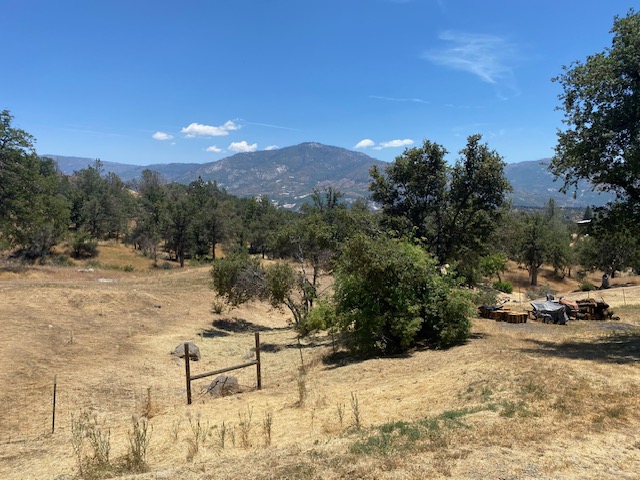
Up to the Hills
Have you ever gone someplace new and been so impressed — you wondered whether you could have lived there?
I had such an experience a couple of days ago — courtesy of my friends at the North Fork History Group.
The history group had set up an excursion to Kinsman Flat above North Fork. That’s where Joe Kinsman — said to be the first white man to settle in the area — built a cabin and started a family in the late 1800’s.
When I heard about the trip, I invited Joetta Fleak — a fellow board member at the Madera County Historical Society and a member of the Madera School Board — to join me.
Joetta is Joe Kinsman’s great-granddaughter.
It was a lovely, cool Monday morning when we set off from my place in Madera County. We made it to North Fork in 45 minutes. From there — our caravan group — 10 people in several vehicles — drove up Mammoth Pool Road about 15 miles to Kinsman Flat.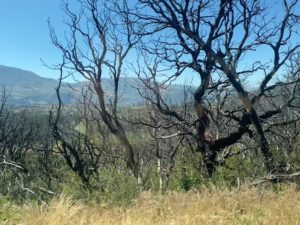
Along the way, we found more evidence of the horrible Creek Fire that had burned nearly 400,000 acres in 2020. That fire was the fifth-biggest in California history. The scars will be there for decades.
But even with the devastation the wildfire caused, the scenery was starkly beautiful.
We made it to the Kinsman Flat cutoff, and drove down the narrow road to Chuck and Roz Thrapp’s place. And that’s where our tale properly begins — at an elevation of 4,000 feet.
Roz and Chuck first came here 44 years ago. They were living in Los Angeles and visiting North Fork. A friend said he wanted to show them a place higher up. So up they went, to Kinsman Flat.
And the moment they saw it, their lives changed. They decided — immediately — they’d leave LA for good and move here.
They bought 20 acres. No home. No jobs. No idea what they’d do.
So they just went to work. Chuck — a skilled plumber — made his name known down in North Fork.
Roz went to work as a waitress at Ducey’s on Bass Lake, when Ducey’s was a very big deal, indeed. Each day — even those days when she had to drive through unplowed, snowy roads — she made that trek to Ducey’s, more than 20 miles away.
She made it. Every day. For years.
And they went about building their home. It’s just lovely — wood and stone, two stories plus a basement. They built a small apartment unit for their parents. They built several out-buildings.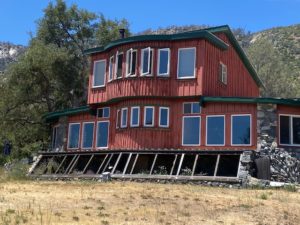
They did all this without electricity or telephone or television. In fact, they didn’t have any of that for the first 19 years they lived at Kinsman.
And they did more than live there. They became a major part of the North Fork community. They went to work raising money for the school there and for needy non-profits. Over the decades, they’ve raised a ton of money and helped a whole lot of people.
And, of course, Chuck became the go-to man for plumbing needs in the area.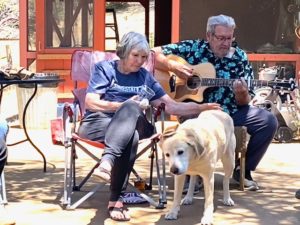
And Chuck — who plays the guitar — also began performing at events in North Fork. He even wrote a song about the community — a song expressing his love for the area. He played his guitar for us and sang his song while we were having lunch. There may have been some dry eyes in our group — but mine were not among them.
Today, it’s fair to say Roz and Chuck are among the most beloved members of the North Fork community — though they live miles outside.
The Thrapps treated us visitors like kings and queens. They made us a sumptuous lunch, which we ate outside on a patio that gave us spectacular views of the nearby peaks.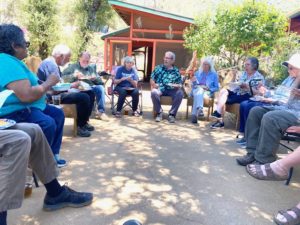
And they told us more of their story. How the Creek Fire had roared down Musick Mountain, jumped the San Joaquin River, and burned right toward their place on that Labor Day weekend in 2020. How they had time only to get their dogs into their two vehicles and speed away, as fast as they could.
They thought their home was doomed, as so many others were. They figured everything was lost. Everything.
It wasn’t until five days later — when they finally were allowed back to their land — that they discovered the fire had burned up to their property, and blown over the top of their home.
They lost some outbuildings. Their land was scorched. But their home was safe.
Forest rangers told them the reason their home had survived was that Chuck had created such a wide clear-cut perimeter around their place.
We had a fine day at the Thrapps. Connie Popelish of the history group — a retired Forest Service archeologist — gave us an excellent talk about Joe Kinsman’s — and others’ — life and times in the late 1800’s.
Joetta had brought some priceless photos of Joe — her great-grandfather, remember — and when they were passed around, you could hear a pin drop.
It was, in short, a magnificent Monday in the mountains. A day of learning. A day of sight-seeing. A day of wondering — could I have done what Roz and Chuck did?
I wanted to say yes. But the truth is — I could not. I did not have — ever — the mechanical skills that Chuck had. My skills were — and are — in reporting and writing, and there was no way to translate them into a living in the mountains.
But a guy can dream, can’t he? And now I will always wonder how my life — our lives — would have been different — could have been different — if we had been able to make a living up there.
After Chuck and Roz had told us their stories, I asked whether there was ever any time — any time at all — in the past 44 years when they thought of moving back to — or closer to — something. Closer to anything.
Their emphatic response: No, of course not.
They said they have been blessed to spend their lives at Kinsman Flat — to have raised their children there — to have lived, simply, a wonderful life in the mountains.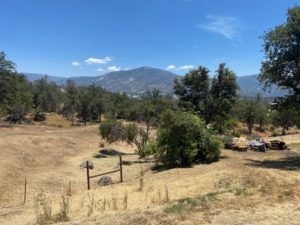
And when you look at what they’ve built — not just their home, but their lives — and when you look at the scenic beauty they’ve enjoyed and lived in — you’d have to agree.
I told Roz and Chuck that they were not the only ones who had been blessed.
We had been, too — our little group, who had been treated so well to their stories and hospitality — we were blessed to be there.
And truly, I meant that.
